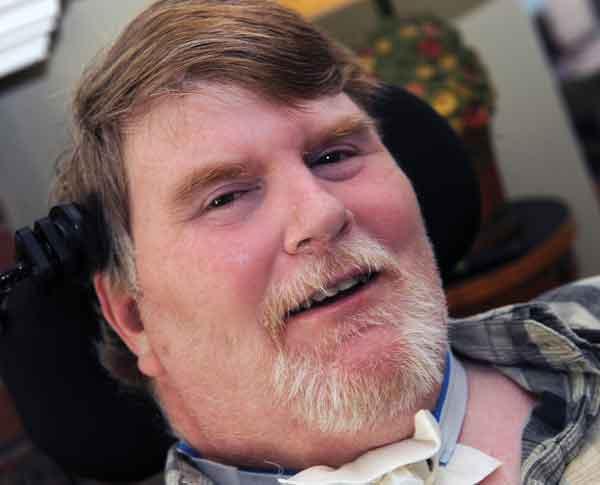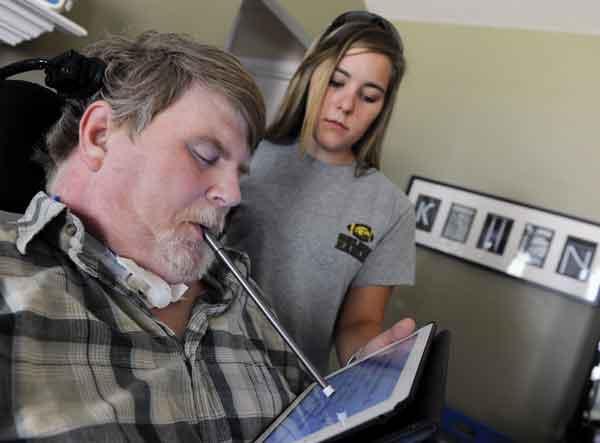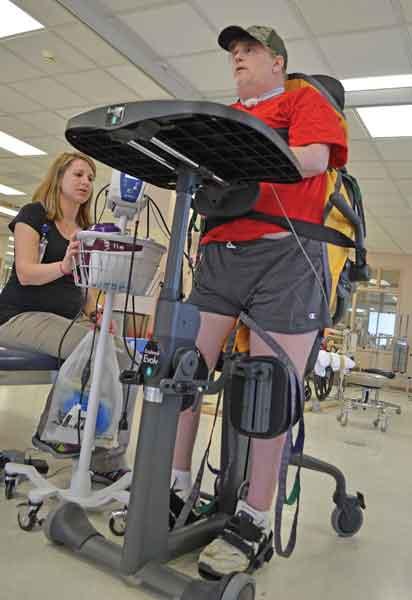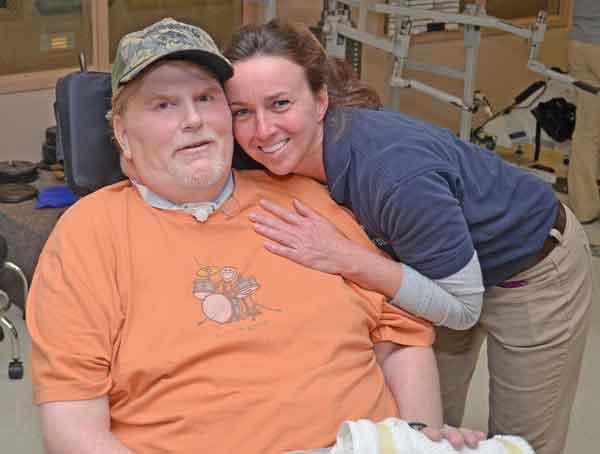Jay Killen couldn’t see with his eyelids sewn shut.
He couldn’t talk with a breathing tube down his throat.
And he sure as heck couldn’t move. All his muscles—even those that control blinking—had been put on strike by a strange, head-to-toe paralysis.
So the Horn Lake man could only listen in horror as doctors discussed removing his life support.
“I overheard them tell my wife, Amanda, that they wanted to take me off my feeding tube and ventilator. I thought: Oh my God.”
And Amanda thought: Oh no you won’t give up on my husband.
“They were talking about him being brain dead … and my gut was telling me it was not correct,” she said. “I sat up with him, playing his favorite Rush album and music from a Wilco concert. I was talking to him and praying and bargaining with God. And he started shaking his leg.
“Nurses kept telling me it was an involuntary reflex. And I kept saying: ‘No, when I tell him I love him, he shakes his leg.’ My mom came the next morning, and she is the one who got the doctors to start asking him questions.”
Jay moved his foot to reply—one twitch for yes and two for no. But there was no answer for the biggest question of all: Why was he paralyzed?
It’s not that doctors at Baptist Memorial-Desoto in Southaven weren’t trying to solve the puzzle. “The chief of pulmonary medicine, the infectious disease doctor and the neurologist were all doing research,” Amanda said.
Guillain Barré Syndrome was a possibility, but the progression of Jay’s paralysis didn’t fit. And he wasn’t a big outdoorsman, so Amanda doubted rabies was right—“unless he had met a rabid raccoon at the trash can.”
Finally, the neurologist suggested food-borne botulism, something he had only seen during his early training. Could Jay have consumed something contaminated by Clostridium botulinum bacterium? Maybe some home-canned food or jarred or preserved meat?
“My husband is a redneck, so Spam is a staple in our house,” Amanda told the doctors, who had never heard of the canned meat. “They are all from other countries, so I had to describe it to them. It was so funny, just the look on their faces.”
The Killens will likely never know what dish did him in. By the time a test came back positive for botulism, Jay’s mother-in-law had helpfully cleaned out their kitchen and fridge.
But at least they had an explanation for his quadriplegia—and soon he was taking an anti-toxin delivered by FedEx. The then 43-year-old was finally on the road to recovery, or was he?
Answered Prayers
According to the Centers for Disease Control, the United States averages about 145 reported cases of botulism each year. About 65 percent are infant botulism, 20 percent wound botulism and 15 percent food-borne.
In 1735, German sausage caused the first recorded case of food-borne botulism, and improperly preserved meats and fish are still a source of the toxin. But vegetables with low acid content are more common culprits, particularly home canned-asparagus, green beans, beets and corn.
Foil-wrapped baked potatoes can be carriers, too, if they’re not kept hot or refrigerated. In 2011, jailhouse moonshine made from a botulism-laced potato sickened eight prisoners in Utah.
Botulism symptoms generally appear 18 to 36 hours after eating a contaminated food and include abdominal cramps, nausea, vomiting, double vision and difficulty swallowing and speaking. Paralysis occurs when the toxin disrupts communication between the nerves and muscles.
Jay’s astonishing descent began on Dec. 11, 2011. “I was having a hard time breathing, my voice became weak and I slowly started becoming limp,” he said.
The next three days were “surreal,” remembers Amanda, the assistant director for the Center for Excellence at Hutchison School in Memphis. “Literally, one day they are telling me he has pneumonia, and the next day they’re saying he’s not going to wake up.”
Overhearing that prognosis, Jay started praying. “I asked God to give me another chance because I didn’t want to give up life with Amanda,” he said.
The couple had been married only two and a half years. Yet they were about to face an extreme test of their “for better or worse” vows.
Jay would eventually endure 17 straight months in hospitals, two Christmases in ICU and several trips to death’s door. And all the while, Amanda would be a fierce advocate for her husband.
“I was going to fight to the death for him if I had to,” she said. “I was not shy about letting people know that. I would get right up in their faces.”
But even in warrior-wife mode, Amanda had trouble wrangling a transfer to an inpatient rehabilitation center. She said a referral to an Atlanta facility fell through when Jay was deemed “too sick.”
“We were really frustrated,” she said. “I knew he was ready to work on something. I kept saying there has got to be another place for him to go.”
Around the same time, Amanda appeared on local TV news and Mollie Kinard of Holly Springs happened to be watching. Before becoming an outreach nurse for Methodist Rehabilitation Center, Kinard was one of Jay’s ICU nurses at Baptist Memorial. And she hadn’t forgotten all he had been through.
“I had seen what he was like the day he came in—from having his eyes sewn shut and communicating with his toe to spelling words and finally speaking,” Kinard said. “He had touched a lot of hearts in the Memphis area. Not many people with botulism as bad as Jay’s live to tell about it.”
Kinard knew Jay needed the benefit of MRC’s expertise, particularly the staff’s experience with paralysis related to neurological illnesses. So she contacted the Killens to set a transfer in motion.
“She was the first one to tell us we can help you,” Jay said. “When I saw the fire in her eyes, I knew it was meant to be.”
“Seven days later, we were there,” Amanda said. “Jay and I looked at each other and said, ‘This is what God has planned.’ It was such a miracle.”
“Even though they did not know much about botulism, they knew about dealing with quadriplegics,” Jay said. “The therapists, the nurses, the techs and the doctors—everybody has been good.”
Keep Working and Have Faith
Until he began rehab, Jay had spent 21 hours a day languishing in bed. At MRC, “it was hit the ground running,” Amanda said.
“The first day they had him up in a wheelchair working and his spirit was good. I feel strongly if he had been able to stay there longer he would be a whole lot closer to walking. After having electrical stimulation and using a stationary bike, he made exponential improvement.”
Still, it was not the turnaround the Killens had once imagined. After Jay was given botulism antitoxin, his ICU doctors had been optimistic. “Originally, they told us it would take three months to come out of the paralysis,” Amanda said. “Then it was six months. Then they said it will just take as long as it takes.
“If they had told me two years ago he would still be bedridden and paralyzed, I would have flipped out.”
While at MRC, the Killens learned why Jay’s impairments might be persisting. Tests indicated he had critical illness polyneuropathy and myopathy, which can develop after extended periods in ICU.
Dr. Samuel Grissom, medical director at MRC, said symptoms include mild to severe weakness, muscular atrophy (particularly in the lower limbs), impaired sensation, limited endurance and delayed weaning from the respirator.
Doctors used to blame the condition on bed rest.
“However, in the early 1980s, studies showed that the abnormalities were often a result of actual degeneration of the nerves and/or muscles,” Grissom said. “That’s why it’s important to identify patients with the syndrome so they can receive comprehensive inpatient rehabilitation.”
“It’s another reason I’ve had slow progress,” said Jay, who’s grateful to have learned the source of his problem. “It made me feel good that someone was willing to take the time and delve a little deeper.”
In the therapy gym, Jay focused on improving his physical abilities and developing strategies to overcome his limitations—like learning to control a power wheelchair. “It gave me freedom I hadn’t had in 14 months to go places by myself,” he said.
Jay also got to sample various tools to control his environment through sessions with George Gober, MRC research associate. It’s how he learned to operate a QuadJoy, a hands-free navigation device for his computer.
On April 4, 2013, Jay was wearing a “Life is Good” T-shirt as he headed home for the first time in almost a year and a half.
And thanks to MRC, Amanda said they felt better prepared for what she jokingly calls “the care and feeding of your take-home quadriplegic.”
Such wisecracks are a constant in the couple’s life, a way to deal with the maddening ups and downs of a chronic illness.
“You can really get far down in a quagmire if you don’t laugh,” Amanda said.
So every time Jay moves a new muscle, they celebrate his “stupid human trick.” And Jay jokes that it’s not all bad being poisoned by the same toxin used in Botox injections.
“I don’t have any wrinkles on my face,” he says. “We joke that he looks 20 years younger than he did before he got sick,” Amanda adds.
Jay has been continuing therapy since he got home, but he hopes to return to MRC for the more rigorous schedule available during an inpatient stay.
Some days he wishes he had a wand that would magically make everything OK. But he’s mostly pragmatic about his plight.
“I don’t know why God chose me for this or if he even did,” he says. “But I do know this has been character-building and faith-building. And it has helped Amanda and I grow closer together.”
As their recent fourth anniversary approached, Jay used his QuadJoy to order Amanda some gifts online. He got her two massage gift certificates (for stress relief) and a St. Christopher medallion (for protection).
“She does so much for me, I don’t know how I’ll ever be able to repay it,” he said. “I want her life to be easier, she has been through hell the past two years.”
Amanda gave Jay a new wedding band, sized to fit a finger that now lies limp and swollen on the arm rest of his wheelchair. The old band hangs from a chain around her neck.
Jay was comatose the night doctors told her to remove the original ring, and she had no idea then how much their lives would change.
But come what may, she knew they would be together. “I’ve always felt, and I still feel, he is going to get better. We have to keep working at it and have faith.”
Methodist Rehab treats a variety of neurological illnesses and conditions. For more information, please call 601-364-3477.




